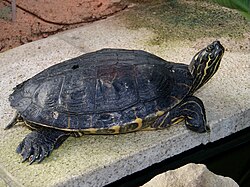- Pseudemys concinna concinna
- Testudo concinna
LeConte, 1830 - Emys annulifera
Gray, 1831 - Emys (Testudo) concinna
— Bonaparte, 1831 - Terrapene concinna
— Bonaparte, 1831 - Clemmys (Clemmys) concinna
— Fitzinger, 1835 - Emys hieroglyphica
Holbrook, 1836 - Emys mobilensis
Holbrook, 1838 - Emys labyrinthica
A.M.C. Duméril & Bibron, 1851 - Emys mobiliensis [sic]
LeConte, 1854(ex errore) - Pseudemys concinna
— Gray, 1856 - Pseudemys hieroglyphica
— Gray, 1856 - Ptychemys concinna
— Agassiz, 1857 - Ptychemys hieroglyphica
— Agassiz, 1857 - Ptychemys hoyi
Agassiz, 1857 - Ptychemys mobiliensis
— Agassiz, 1857 - Clemmys hieroglyphica
— Strauch, 1862 - Clemmys labyrinthica
— Strauch, 1862 - Clemmys mobilensis
— Strauch, 1862 - Pseudemys mobiliensis
— Gray, 1863 - Emys orthonyx
Wied, 1865 - Pseudemys labyrinthica
— Gray, 1870 - Trachemys annulifera
Gray, 1873 - Pseudemys mobilensis
— Yarrow, 1883 - Chrysemys concinna
— Boulenger, 1889 - Chrysemys hieroglyphica
— Boulenger, 1889 - Chrysemys mobiliensis
— Boulenger, 1889 - Clemmys mobiliensis
— Strauch, 1890 - Chrysemys labyrinthica
— O.P. Hay, 1892 - Pseudemys elonae
Brimley, 1928 - Pseudemys vioscana
Brimley, 1928 - Pseudemys floridana concinna
— Carr, 1935 - Pseudemys floridana mobiliensis
— Carr, 1937 - Pseudemys concinna hoyi
— Stejneger, 1938 - Pseudemys floridana hieroglyphica
— Carr, 1938 - Pseudemys concinna concinna
— Stejneger & Barbour, 1939 - Pseudemys concinna hieroglyphica
— Stejneger & Barbour, 1939 - Pseudemys concinna mobilensis
— Stejneger & Barbour, 1939 - Pseudemys floridana mobilensis
— Pope, 1939 - Pseudemys floridana hoyi
— B.C. Brown, 1950 - Pseudemys concinna mobiliensis
— Carr, 1952 - Pseudemys virginica
— Pasteels, 1957(nomen nudum) - Chrysemys concinna concinna
— Weaver & Rose, 1967 - Chrysemys concinna hieroglyphica
— Weaver & Rose, 1967 - Chrysemys concinna mobilensis
— Cochran & Goin, 1970 - Chrysemys floridana hoyi
— Cochran & Goin, 1970 - Pseudemys concinna metteri
Ward, 1984 - Pseudemys floridana noyi [sic]
Ferri, 2002(ex errore)
- Pseudemys concinna suwanniensis
- Pseudemys floridana suwanniensis
Carr, 1937 - Pseudemys concinna suwanniensis
— Stejneger & Barbour, 1939 - Pseudemys concinna suuranniensis [sic]
Rhodes, 1966(ex errore) - Chrysemys concinna suwanniensis
— Weaver & Rose, 1967 - Pseudemys sueanniensis [sic]
Nothstine, Davis & DeRoos, 1971
(ex errore) - Pseudemys suenniensis [sic]
Dadd, 1974(ex errore) - Pseudemys suwanniensis
— Collins, 1991
|


